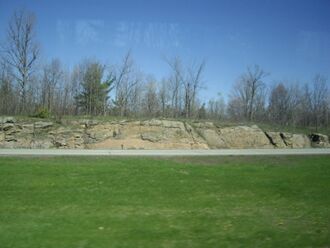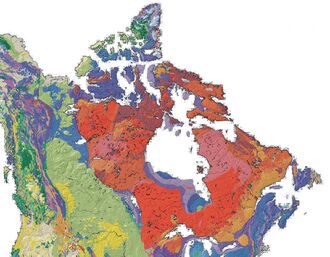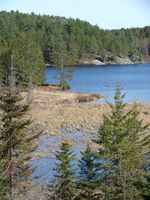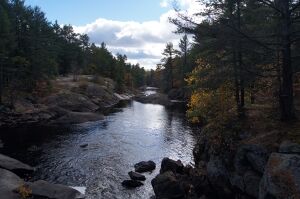الدرع الكندي
| الدرع الكندي Canadian Shield | |
|---|---|
| النطاق الطباقي: قبل الكامبري | |
 تضاريس الدرع الكندي | |
| النوع | درع |
| وحدة في | North American craton |
| الوحدات المكوّنة | Laurentian Upland Kazan Davis Hudson James[1] |
| المساحة | 8,000,000 كم²[2] |
| الخصائص الصخرية | |
| الرئيسي | صخور متحولة |
| الموقع | |
| المنطقة | شمال أمريكا |
| البلد | |
| مقطع النوع | |
| مسماة على اسم | كندا |
 The Canadian Shield is a broad region of Precambrian rock (pictured in shades of red) that encircles خليج هدسون. It spans eastern, northeastern, and east-central كندا and the northern portion of the upper midwestern الولايات المتحدة. | |
الدرع الكندي Canadian Shield منطقة صخرية شاسعة تلتف حول خليج هدسون مثل حدوة حصان ضخمة. وتغطي نصف مساحة كندا من اليابسة. وتشمل معظم جزيرة بافين، وكل مساحة لبرادور، وتسعة أعشار مقاطعة كويبك، وأكثر من نصف مساحة اونتاريو ومانيتوبا، ومساحات واسعة من ساسكاتشوان ونوناڤوت والمناطق الشمالية الغربية. وتقع 4,586,900 كم² من مجموع مساحة الدرع البالغ قدره 4,827,738 كم² في كندا. ويمتد الدرع أيضاً إلى الولايات المتحدة مكوناً جبال أديرونداك في نيويورك وجزر بحيرة سوپيريور، في مشيگن، ووسكنسن ومينيسوتا. ويسمى الدرع الكندي أيضًا بهضبة لورينشيان، وهي امتداد للجبال اللورنشية في جنوبي كويبك.
الامتداد الجغرافي
The Canadian Shield is a physiographic division comprising four smaller physiographic provinces: the Laurentian Upland, Kazan Region, Davis and James.[1] The shield extends into the United States as the Adirondack Mountains (connected by the Frontenac Axis) and the Superior Upland. The Canadian Shield is a U-shaped subsection of the Laurentia craton signifying the area of greatest glacial impact (scraping down to bare rock) creating the thin soils. The age of the Canadian Shield is estimated to be 4.28 Ga. The Canadian Shield once had jagged peaks, higher than any of today's mountains, but millions of years of erosion have changed these mountains to rolling hills.[3]
The Canadian Shield is a collage of Archean plates and accreted juvenile arc terranes and sedimentary basins of the Proterozoic Eon that were progressively amalgamated during the interval 2.45–1.24 Ga, with the most substantial growth period occurring during the Trans-Hudson orogeny, between c. 1.90–1.80 Ga.[4] The Canadian Shield was the first part of North America to be permanently elevated above sea level and has remained almost wholly untouched by successive encroachments of the sea upon the continent. It is the Earth's greatest area of exposed Archean rock. The metamorphic base rocks are mostly from the Precambrian (between 4.5 Ga and 540 Ma) and have been repeatedly uplifted and eroded. Today it consists largely of an area of low relief 300–610 m (980–2,000 ft) above sea level with a few monadnocks and low mountain ranges (including the Laurentian Mountains) probably eroded from the plateau during the Cenozoic Era. During the Pleistocene Epoch, continental ice sheets depressed the land surface (creating Hudson Bay) but also tilted up its northeastern "rim" (the Torngat), scooped out thousands of lake basins, and carried away much of the region's soil. The northeastern portion, however, became tilted up so that, in northern Labrador and Baffin Island, the land rises to more than 1,500 metres (5,000 feet) above sea level.
When the Greenland section is included, the Canadian Shield is approximately circular, bounded on the northeast by the northeast edge of Greenland, with Hudson Bay in the middle. It covers much of Greenland, all of Labrador and the Great Northern Peninsula of Newfoundland, most of Quebec north of the St. Lawrence River, much of Ontario including northern sections of the Ontario Peninsula, the Adirondack Mountains[5] of New York, the northernmost part of Lower Michigan and all of Upper Michigan, northern Wisconsin, northeastern Minnesota, the central and northern portions of Manitoba, northern Saskatchewan, a small portion of northeastern Alberta,[6] mainland Northwest Territories to the east of a line extended north from the Saskatchewan-Alberta border, most of Nunavut's mainland and, of its Arctic Archipelago, Baffin Island and significant bands through Somerset, Southampton, Devon and Ellesmere islands.[2] In total, the exposed area of the shield covers approximately 8,000,000 km2 (3,100,000 sq mi). The true extent of the shield is greater still and stretches from the Western Cordillera in the west to the Appalachians in the east and as far south as Texas, but these regions are overlaid with much younger rocks and sediment.
جيولوجيا
درع ما قبل الكمبري هو جزء من رسيخة craton، تتبع زمن ما قبل الكمبري، وظاهرة على وجه الأرض.[7]
يقدّر علماء الجيولوجيا عمر الصخور التي تكون معظم أجزاء الدرع بنحو 600 مليون إلى 5 بليون سنة. وقد تعرض معظم الصخور إلى فترة أو أكثر اشتد فيها نشاط تكوين الجبال. وقد أدى كل من الضغط والحرارة الشديدين، في هذه الفترات، إلى تكوين جبال مرتفعة من الجرانيت والديوريت والمرويت، وغيرها من الصخور البلورية. وقد تعرضت الجبال لتأثير المناخ والتعرية. ونرى اليوم جزءًا كبيرًا من الأقسام الوسطى والشمالية الغربية للدرع قد انخفض ارتفاعها وأصبحت مسطحة. ويبلغ ارتفاع الجبال في الجزء الشمالي الشرقي 2,590م. ولا يقيم في هذه المناطق إلا القليل من السكان، ولا تصلح للزراعة إلا في مساحات ضئيلة منها. وانتشرت في الدرع بحيرات كثيرة، وقد أصبح بعضها مناطق سياحية. توجد في الجزء الجنوبي غابات تُعَد من أهم مصادر الثروة الطبيعية. ويزخر الدرع الكندي أيضًا بالنحاس والذهب والحديد والنيكل واليورانيوم وغيرها من المعادن.
The Canadian Shield is among the oldest geologic areas on Earth, with regions dating from 2.5 to 4.2 billion years.[8] The multitude of rivers and lakes in the region is classical example of a deranged drainage system, caused by the watersheds of the area being disturbed by glaciation and the effect of post-glacial rebound.[9] The shield was originally an area of very large, very tall mountains (about 12,000 m or 39,000 ft)[10] with much volcanic activity, but the area was eroded to nearly its current topographic appearance of relatively low relief over 500 Ma.[11][12] Erosion has exposed the roots of the mountains, which take the form of greenstone belts in which belts of volcanic rock that have been altered by metamorphism are surrounded by granitic rock. These belts range in age from 3.6 to 2.7 Ga.[13] Much of the granitic rock belongs to the distinctive tonalite–trondhjemite–granodiorite family of rocks, which are characteristic of Archean continental crust.[14] Many of Canada's major ore deposits are associated with greenstone belts.[15]
The Sturgeon Lake Caldera in Kenora District, Ontario, is one of the world's best preserved mineralized Neoarchean caldera complexes, which is 2.7 Ga.[16] The Canadian Shield also contains the Mackenzie dike swarm, which is the largest dike swarm known on Earth.[17] The North American craton is the bedrock forming the heart of the North American continent, and the Canadian Shield is the largest exposed part of the craton's bedrock. The Canadian Shield is part of an ancient continent called Arctica, which was formed about 2.5 Ga during the Neoarchean era.
Mountains have deep roots and float on the denser mantle much like an iceberg at sea. As mountains erode, their roots rise and are eroded in turn. The rocks that now form the surface of the shield were once far below the Earth's surface. The high pressures and temperatures at those depths provided ideal conditions for mineralization. Although these mountains are now heavily eroded, many large mountains still exist in Canada's far north called the Arctic Cordillera. This is a vast, deeply dissected mountain range, stretching from northernmost Ellesmere Island to the northernmost tip of Labrador. The range's highest peak is Nunavut's Barbeau Peak at 2,616 metres (8,583 ft) above sea level.[18] Precambrian rock is the major component of the bedrock.
Weathered Precambrian pillow lava in the Temagami Greenstone Belt
Folded Precambrian gneiss of the Canadian Shield in Georgian Bay, Ontario
البيئة
The current surface expression of the shield is one of very thin soil lying on top of the bedrock, with many bare outcrops. This arrangement was caused by severe glaciation during the ice ages that covered the shield and scraped the rock clean. The lowlands of the Canadian Shield have a very dense soil that is not suitable for forestation; it also contains many marshes and bogs (muskegs). The rest of the region has coarse soil that does not retain moisture well and is frozen with permafrost throughout the year. Forests are not as dense in the north.
The shield is covered in parts by vast boreal forests in the south that support natural ecosystems as well as a major logging industry. The boreal forest area gives way to the Eastern Canadian Shield taiga that covers northern Quebec and most of Labrador. The Midwestern Canadian Shield forests that run westwards from Northwestern Ontario have boreal forests that give way to taiga in the most northerly parts of Manitoba and Saskatchewan. Hydrologic drainage is generally poor, the soil compacting effects of glaciation being one of the many causes. Tundra typically prevails in the northern regions.
Many mammals such as beaver, caribou, white-tailed deer, moose, wolves, wolverines, weasels, mink, otters, grizzly bear, polar bears and black bears are present.[19] In the case of polar bears (Ursus maritimus), the shield area contains many of their denning locations, such as the Wapusk National Park.[20] The many lakes and rivers on the shield contain a plentiful quantity of different sports fish species, including walleye, northern pike, lake trout, yellow perch, whitefish, brook trout, arctic grayling, and many types of baitfish.[21] The water surfaces are also home to many waterfowl, most notably Canada geese, loons and gulls.[22] The vast forests contain a myriad population of other birds, including ravens and crows, predatory birds and many songbirds.
التعدين والاقتصاد
The Canadian Shield is one of the world's richest areas in terms of mineral ores. It is filled with substantial deposits of nickel, gold, silver, and copper. There are many mining towns extracting these minerals. The largest, and one of the best known, is Sudbury, Ontario. Sudbury is an exception to the normal process of forming minerals in the shield since the Sudbury Basin is an ancient meteorite impact crater. Ejecta from the meteorite impact was found in the Rove Formation in May 2007. The nearby but less-known Temagami Magnetic Anomaly has striking similarities to the Sudbury Basin. This suggests it could be a second metal-rich impact crater.[23] In northeastern Quebec, the giant Manicouagan Reservoir is the site of an extensive hydroelectric project (Manic-cinq, or Manic-5). This is one of the largest-known meteorite impact craters on Earth, though not as large as the Sudbury crater.
The Flin Flon greenstone belt in central Manitoba and east-central Saskatchewan "is one of the largest Paleoproterozoic volcanic-hosted massive sulfide (VMS) districts in the world, containing 27 copper-zinc-(gold) deposits from which more than 183 million tonnes of sulfide have been mined."[24] The portion in the Northwest Territories has recently been the site of several major diamond discoveries. The kimberlite pipes in which the diamonds are found are closely associated with cratons, which provide the deep lithospheric mantle required to stabilize diamond as a mineral. The kimberlite eruptions then bring the diamonds from over 150 kilometres (93 mi) depth to the surface. The Ekati and Diavik mines are actively mining kimberlite diamonds.
انظر أيضاً
- Baltic Shield
- Athabasca Basin
- Geology of Ontario
- Platform (geology)
- Basement (geology)
- Volcanology of Canada
- Wisconsin glaciation
- Glacial history of Minnesota
- Geography of Canada
- أقدم حجر
- النشاط البركاني في كندا
المصادر
- ^ أ ب The Atlas of Canada (12 September 2016). "Physiographic Regions Map". Natural Resources Canada. Retrieved 2019-11-15.
- ^ أ ب "Canadian Shield". Encyclopædia Britannica. Archived from the original on 2015-06-24. Retrieved 2009-02-10.
- ^ Alexander Murray; Harrisson Panabaker; Holy O'Rourke; David Barrett (7 February 2006). "Canadian Shield". The Canadian Encyclopedia. Retrieved 29 May 2024.
Formed over 3 billion years through processes such as plate tectonics, erosion and glaciation
- ^ Corrigan, D. (2008). "Metallogeny and Tectonic Evolution of the Trans-Hudson Orogen" (PDF). Archived from the original (PDF) on April 9, 2008. Retrieved 2008-03-05.
- ^ Peterson Field Guide to Geology of Eastern North America by Roberts, David & Roger Tory Peterson.
- ^ Alberta Heritage - Alberta Online Encyclopedia Archived 2010-12-08 at Archive-It - The Canadian Shield Region of Alberta
- ^ عبد الجليل هويدي، محمد أحمد هيكل (2004). أساسيات الجيولوجيا التاريخية. مكتبة الدار العربية للكتب.
- ^ Tsuyoshi Iizuka, at al., "Geology and Zircon Geochronology of the Acasta Gneiss Complex", Precambrian Research, 153 (2007) pp. 179–208
- ^ Pidwirny, M. (2006). "The Drainage Basin Concept". Fundamentals of Physical Geography (2nd ed.).
- ^ Clark, Bruce W. (1999). "Geologic History". Making Connections: Canada's geography. Scarborough, Ontario: Prentice Hall Ginn Canada. pp. 95. ISBN 978-0-13-012635-1.
- ^ Ambrose, J. W. (1 September 1964). "Exhumed paleoplains of the Precambrian Shield of North America". American Journal of Science. 262 (7): 817–857. Bibcode:1964AmJS..262..817A. doi:10.2475/ajs.262.7.817.
- ^ Shilts, William W.; Aylsworth, Janice M.; Kaszycki, Christine A.; Klassen, Rodney A. (1987). "Canadian Shield". Geomorphic Systems of North America: 119–161. doi:10.1130/DNAG-CENT-v2.119. ISBN 0813753023.
- ^ Card, K.D. (August 1990). "A review of the Superior Province of the Canadian Shield, a product of Archean accretion". Precambrian Research. 48 (1–2): 99–156. Bibcode:1990PreR...48...99C. doi:10.1016/0301-9268(90)90059-Y.
- ^ Smithies, R.H (15 October 2000). "The Archaean tonalite–trondhjemite–granodiorite (TTG) series is not an analogue of Cenozoic adakite". Earth and Planetary Science Letters. 182 (1): 115–125. Bibcode:2000E&PSL.182..115S. doi:10.1016/S0012-821X(00)00236-3.
- ^ de Geoffroy, J.; Wignall, T. K. (1 May 1971). "A probabilistic appraisal of mineral resources in a portion of the Grenville Province of the Canadian shield". Economic Geology. 66 (3): 466–479. Bibcode:1971EcGeo..66..466D. doi:10.2113/gsecongeo.66.3.466.
- ^ Caldera Volcanoes Archived 2012-08-14 at the Wayback Machine Retrieved on 2007-07-20
- ^ Pilkington, Mark; Roest, Walter R. (1998). "Removing varying directional trends in aeromagnetic data". Geophysics. 63 (2): 446–453. Bibcode:1998Geop...63..446P. doi:10.1190/1.1444345.
- ^ قالب:Cite bivouac
- ^ قالب:NatGeo ecoregion
- ^ C. Michael Hogan (2008) Polar Bear: Ursus maritimus, Globaltwitcher.com, ed. Nicklas Stromberg Archived ديسمبر 24, 2008 at the Wayback Machine
- ^ "Making Sense of Shield Lakes and Rivers | Northern Ontario Travel". 28 June 2016.
- ^ "Wildlife of the Boreal Shield Ecozone".
- ^ 3-D Magnetic Imaging using Conjugate Gradients: Temagami anomaly Archived 2009-07-11 at the Wayback Machine Retrieved on 2008-03-12
- ^ Troymet Exploration, Report on the 2007 Diamond Drilling Program, McClarty Lake Project, Manitoba: The Pas Mining District NTS 63-K-08; UTM ZONE 14 N 415938 E, 6038968 N; 54° 29′ 28″ N 100° 17′ 52″ W, by Jessica Norris & Tracy Hurley (Whitehorse, Yukon: Aurora Geosciences, 2007‑09‑24).
- Webarchive template other archives
- Short description is different from Wikidata
- Articles containing لاتينية-language text
- Pages with empty portal template
- رسائخ
- جيولوجيا أونتاريو
- جيولوجيا مشيگن
- جيولوجيا كوبيك
- جيولوجيا مينيسوتا
- جيولوجيا نيوفاوندلاند ولبرادور
- جيولوجيا نيويورك
- جيولوجيا ويسكنسن
- جيولوجيا مانيتوبا
- جيولوجيا ساسكاتشوان
- جيولوجيا نوناڤوت
- جيولوجيا المقاطعات الشمالية الغربية
- جيولوجيا ألبرتا
- جيولوجيا گرينلاند
- تقسيمات جغرافية
- جيولوجيا إقليمية
- Stratigraphy of Canada





